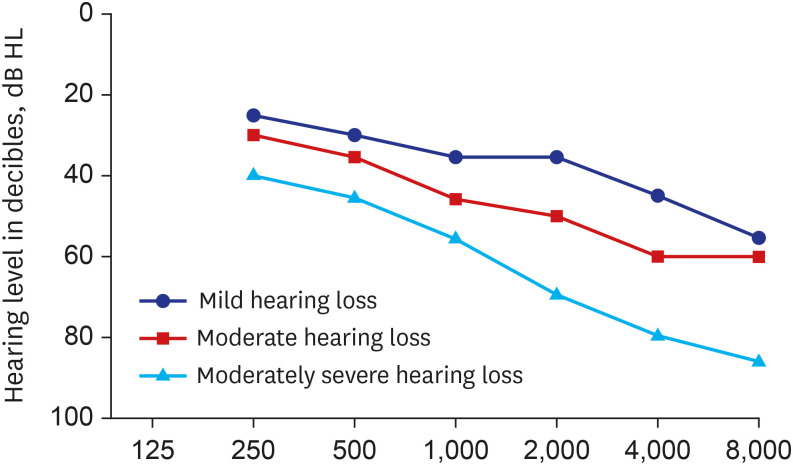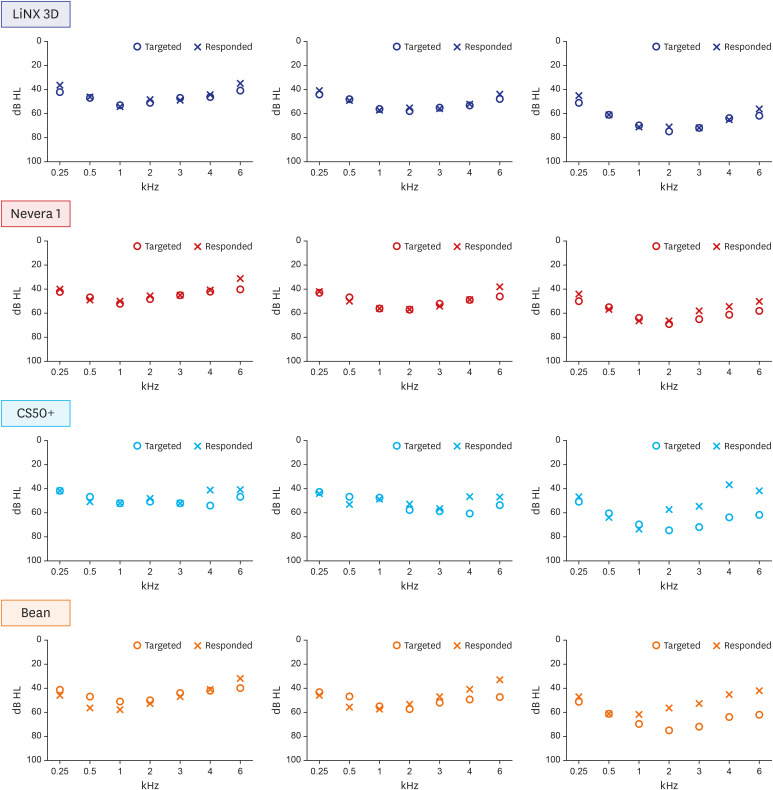J Korean Med Sci.
2022 Mar;37(12):e94. 10.3346/jkms.2022.37.e94.
Hearing and Speech Perception for People With Hearing Loss Using Personal Sound Amplification Products
- Affiliations
-
- 1Hearing Research Laboratory, Samsung Medical Center, Seoul, Korea
- 2Sungkyunkwan University School of Medicine, Seoul, Korea
- 3Department of Otorhinolaryngology-Head and Neck Surgery, Sungkyunkwan University School of Medicine, Samsung Medical Center, Seoul, Korea
- 4Medical Research Institute, Sungkyunkwan University School of Medicine, Suwon, Korea
- 5Center for Clinical Epidemiology, Samsung Medical Center, Seoul, Korea
- KMID: 2527635
- DOI: http://doi.org/10.3346/jkms.2022.37.e94
Abstract
- Background
Hearing loss (HL) is the most common chronic disease and has been linked to negative health outcomes. Hearing aids (HAs) are regarded as the gold standard for HL management, however, the adoption rate of HAs is relatively low for various reasons. With this background, hearing devices, such as personal sound amplification products (PSAPs) received significant attention as an alternative to conventional HAs. This study aimed to evaluate the clinical efficacy of PSAPs in patients with mild to moderately severe HL.
Methods
Nineteen patients with mild hearing loss (MHL), 23 with moderate hearing loss (MDHL), and 15 with moderately severe hearing loss (MSHL) participated in the study. Electroacoustic analysis, simulated real-ear measurements (REMs), and three clinical evaluations were implemented.
Results
All devices satisfied the electroacoustic tolerances. All devices provided sufficient gain for MHL and MDHL audiograms. However, in MSHL audiogram, the gains of PSAPs were insufficient, especially for high frequencies. In terms of clinical evaluations, soundfield audiometry showed significant improvements between aided and unaided thresholds in all groups for all devices (P < 0.001). Significant improvements of word recognition scores were only shown for HAs between aided and unaided conditions. The Korean version of the Hearing In Noise Test did not show any consistent findings for all devices and groups.
Conclusion
Certain PSAPs are beneficial for improving hearing and speech perception in patients with HL. Well-chosen PSAPs could be an alternative hearing rehabilitation option for these patients.
Keyword
Figure
Reference
-
1. World Health Organization. Deafness and hearing loss. Updated 2021. Accessed May 20, 2021. https://www.who.int/news-room/fact-sheets/detail/deafness-and-hearing-loss .2. Collins JG. Prevalence of selected chronic conditions: United States, 1990–1992. Vital Health Stat 10. 1997; (194):1–89.3. Cosh S, Helmer C, Delcourt C, Robins TG, Tully PJ. Depression in elderly patients with hearing loss: current perspectives. Clin Interv Aging. 2019; 14:1471–1480. PMID: 31616138.4. Dalton DS, Cruickshanks KJ, Klein BE, Klein R, Wiley TL, Nondahl DM. The impact of hearing loss on quality of life in older adults. Gerontologist. 2003; 43(5):661–668. PMID: 14570962.5. Lin FR, Yaffe K, Xia J, Xue QL, Harris TB, Purchase-Helzner E, et al. Health ABC Study Group. Hearing loss and cognitive decline in older adults. JAMA Intern Med. 2013; 173(4):293–299. PMID: 23337978.6. Livingston G, Huntley J, Sommerlad A, Ames D, Ballard C, Banerjee S, et al. Dementia prevention, intervention, and care: 2020 report of the Lancet Commission. Lancet. 2020; 396(10248):413–446. PMID: 32738937.7. Reed NS, Altan A, Deal JA, Yeh C, Kravetz AD, Wallhagen M, et al. Trends in health care costs and utilization associated with untreated hearing loss over 10 years. JAMA Otolaryngol Head Neck Surg. 2019; 145(1):27–34. PMID: 30419131.8. Willink A, Reed NS, Lin FR. Cost-benefit analysis of hearing care services: what is it worth to medicare? J Am Geriatr Soc. 2019; 67(4):784–789. PMID: 30641615.9. Powers TA, Rogin CM. MarkeTrak 10: hearing aids in an era of disruption and DTC/OTC devices. Hear Rev. 2019; 26(8):12–20.10. President’s Council of Advisors on Sciences and Technology (PCAST). Aging America & hearing loss: imperative of improved hearing technologies. Updated 2015. Accessed August 1, 2021. https://obamawhitehouse.archives.gov/sites/default/files/microsites/ostp/PCAST/PCAST%20hearing%20letter%20report.pdf .11. National Academies of Sciences, Engineering, and Medicine (NASEM). Hearing Health Care for Adults: Priorities for Improving Access and Affordability. Washington, D.C., USA: The National Academies Press;2016.12. US Food and Drug Administration (FDA). Regulatory Requirements for Hearing Aid Devices and Personal Sound Amplification Products -Draft Guidance for Industry and Food and Drug Administration Staff. Updated 2013. Accessed August 1, 2021. https://www.fda.gov/regulatory-information/search-fda-guidance-documents/regulatory-requirements-hearing-aid-devices-and-personal-sound-amplification-products-draft-guidance .13. Callaway SL, Punch JL. An electroacoustic analysis of over-the-counter hearing aids. Am J Audiol. 2008; 17(1):14–24. PMID: 18519576.14. Kim GY, Kim JS, Jo M, Seol HY, Cho YS, Moon IJ. Feasibility of personal sound amplification products in patients with moderate hearing loss: a pilot study. Clin Exp Otorhinolaryngol. 2022; 15(1):60–68. PMID: 33541032.15. Reed NS, Betz J, Lin FR, Mamo SK. Pilot electroacoustic analyses of a sample of direct-to-consumer amplification products. Otol Neurotol. 2017; 38(6):804–808. PMID: 28595255.16. Seol HY, Kim GY, Kang S, Jo M, Han UG, Cho YS, et al. Clinical comparison of a hearing aid, a personal sound amplification product, and a wearable augmented reality device. Clin Exp Otorhinolaryngol. 2021; 14(3):359–361. PMID: 33735561.17. Smith C, Wilber LA, Cavitt K. PSAPs vs hearing aids: an electroacoustic analysis of performance and fitting capabilities. Hear Rev. 2016; 23(7):18.18. Manchaiah V, Taylor B, Dockens AL, Tran NR, Lane K, Castle M, et al. Applications of direct-to-consumer hearing devices for adults with hearing loss: a review. Clin Interv Aging. 2017; 12:859–871. PMID: 28553093.19. Kim JS, Lim D, Hong HN, Shin HW, Lee KD, Hong BN, et al. Development of Korean-Standard Monosyllabic Word Lists for Adults (KS-MWL-A). Audiology. 2008; 4(2):126–140.20. Moon SK, Kim SH, Mun HA, Jung HK, Lee JH, Choung YH, et al. The Korean hearing in noise test. Int J Audiol. 2008; 47(6):375–376. PMID: 18569115.21. Cho YS, Park SY, Seol HY, Lim JH, Cho YS, Hong SH, et al. Clinical performance evaluation of a personal sound amplification product vs a basic hearing aid and a premium hearing aid. JAMA Otolaryngol Head Neck Surg. 2019; 145(6):516–522. PMID: 31095263.22. Brody L, Wu YH, Stangl E. A comparison of personal sound amplification products and hearing aids in ecologically relevant test environments. Am J Audiol. 2018; 27(4):581–593. PMID: 30458521.23. Choi JE, Kim J, Yoon SH, Hong SH, Moon IJ. A personal sound amplification product compared to a basic hearing aid for speech intelligibility in adults with mild-to-moderate sensorineural hearing loss. J Audiol Otol. 2020; 24(2):91–98. PMID: 31842534.
- Full Text Links
- Actions
-
Cited
- CITED
-
- Close
- Share
- Similar articles
-
- Comparative Effectiveness of Personal Sound Amplification Products Versus Hearing Aids for Unilateral Hearing Loss: A Prospective Randomized Crossover Trial
- Study on Effective Improvement of Mobile Phone Sound Quality in a Noise Environment for the Hearing-Impaired
- Pure tone hearing threshold and maximum speech discrimination scorein sensori-neural hearing loss
- Current Developments and Challenge of Implantable Bone Conduction Hearing Aids
- Outcomes of Direct-to-Consumer Hearing Devices for People with Hearing Loss: A Review



